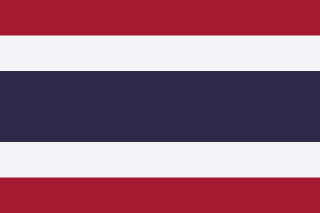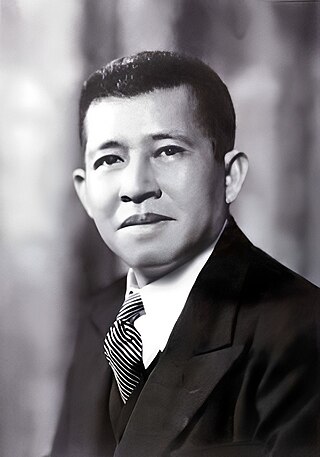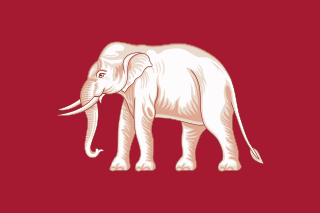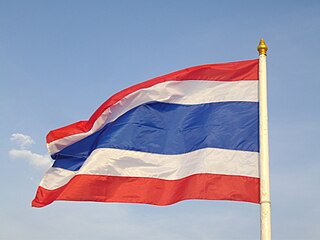
The Tai or Thai ethnic group migrated into mainland Southeast Asia over a period of centuries. The word Siam may have originated from Pali, Sanskrit श्याम, or Mon ရာမည, with likely the same root as Shan and Ahom. Xianluo was the Chinese name for the Ayutthaya Kingdom, merged from Suphannaphum city-state, centered in modern-day Suphan Buri; and Lavo city-state, centered in modern-day Lop Buri. To the Thai, the name of their country has mostly been Mueang Thai.

Field Marshal Sarit Thanarat was a Thai military officer who staged a coup in 1957, replacing Plaek Phibunsongkhram as Thailand's prime minister until Sarit died in 1963. He was born in Bangkok, but grew up in his mother's home town in Isan-speaking northeastern Thailand and considered himself from Isan. His father, Major Luang Ruangdetanan, was a career army officer best known for his translations into Thai of Cambodian literature. He had partial Chinese ancestry.

Field Marshal Plaek Phibunsongkhram, locally known as Marshal P., and contemporarily known as Phibun in the West, was a Thai politician, military officer, and revolutionary who served as the 3rd prime minister of Thailand from 1938 to 1944 and again from 1948 to 1957.

The flag of Thailand shows five horizontal stripes in the colours red, white, blue, white and red, with the central blue stripe being twice as wide as each of the other four. The design was adopted on 28 September 1917, according to the royal decree issued by Rama VI. Since 2016, that day is a national day of importance in Thailand celebrating the flag.

Vajiravudh was the sixth king of Siam from the Chakri dynasty, titled Rama VI. He reigned from 1910 until his death in 1925. King Vajiravudh is best known for his efforts to create and promote Siamese nationalism. His reign was characterized by Siam's movement further towards democracy and minimal participation in World War I. He had keen interests in Siamese history, archaeology, and literature, as well as economics, politics and world affairs, and founded the country's first university, Chulalongkorn University.

Pridi Banomyong, also known by his noble title Luang Praditmanutham, was a Thai statesman and professor. He served in multiple ministerial posts, as regent, and as prime minister in Thailand. He led the civilian wing of Khana Ratsadon, and helped found the University of Moral and Political Sciences and the Bank of Thailand.

Prajadhipok was the seventh king of Siam from the Chakri dynasty, titled Rama VII. His reign was a turbulent time for Siam due to political and social changes during the 1932 Siamese revolution. He is to date the only Siamese monarch of the Chakri dynasty to abdicate.

The Rattanakosin Kingdom, the Kingdom of Siam, or the RattanakosinEmpire, were names used to reference the fourth and current Thai kingdom in the history of Thailand. It was founded in 1782 with the establishment of Rattanakosin (Bangkok), which replaced the city of Thonburi as the capital of Siam. This article covers the period until the Siamese revolution of 1932.

The history of Thailand from 1932 to 1973 was dominated by military dictatorships which were in power for much of the period. The main personalities of the period were the dictator Luang Phibunsongkhram, who allied the country with Japan during the Second World War, and the civilian politician Pridi Banomyong, who founded Thammasat University and was briefly prime minister after the war.

Khuang Aphaiwong, also known by his noble title Luang Kowit-aphaiwong, was the founder of the Democrat Party and three times the prime minister of Thailand: from August 1944 to 1945, from January to May 1946, and from November 1947 to April 1948.

Major-General Luang Wichitwathakan was a Thai politician, diplomat, historian, novelist, and playwright. He is credited with changing the name of the country from Siam to Thailand.

Rambai Barni, formerly Rambai Barni Svastivatana, was Queen of Siam as the wife of King Prajadhipok of Siam.

Thailand officially adopted a neutral position during World War II until the five hour-long Japanese invasion of Thailand on 8 December 1941, which led to an armistice and military alliance treaty between Thailand and the Japanese Empire in mid-December 1941. At the start of the Pacific War, the Japanese Empire pressured the Thai government to allow the passage of Japanese troops to invade British-held Malaya and Burma. After the invasion, Thailand capitulated. The Thai government under Plaek Phibunsongkhram considered it profitable to co-operate with the Japanese war efforts, since Thailand saw Japan – who promised to help Thailand regain some of the Indochinese territories which had been lost to France – as an ally against Western imperialism. Following added pressure from the start of the Allied bombings of Bangkok due to the alliance with Japan, Thailand declared war on the United Kingdom and the United States and annexed territories in neighbouring countries, expanding to the north, south, and east, gaining a border with China near Kengtung.

Prince Boworadej was a Thai attempted-coup leader, government official, General, and royalty. After defeat in the 1933 rebellion, he sought asylum in Cambodia where he lived until 1948 when he returned to Thailand and died in 1953.

The Siamese revolution of 1932 or Siamese coup d'état of 1932 was a coup d'état by the People's Party which occurred in Siam on 24 June 1932. It ended Siam's centuries-long absolute monarchy rule under the Chakri dynasty and resulted in a bloodless transition of Siam into a constitutional monarchy, the introduction of democracy and the first constitution, and the creation of the National Assembly. Dissatisfaction caused by the economic crisis, the lack of a competent government, and the rise of Western-educated commoners fueled the revolution.

The coup d'état of 8 November 1947 was a military coup d'état that took place in Thailand on the evening of 8 November 1947 and ended in the early morning hours of 9 November. The coup ousted the government of Pridi Banomyong's frontman, Luang Thamrong, to make royalist Khuang Aphaiwong Prime Minister of Thailand. The coup was led by Plaek Phibunsongkhram, Phin Choonhavan and Kat Katsongkhram as a bid to regain the royalists' political power and Crown Property back from the reforms of the Siamese revolution of 1932. The influence of the People Party ended as Pridi left the country on exile.

The Ministry of Interior of the Kingdom of Thailand is a cabinet-level department in the Government of Thailand. The ministry has wide ranging responsibilities. It is responsible for local administration, internal security, citizenship, disaster management, road safety, land management, issuance of national identity cards, and public works. The ministry is responsible for appointing the 76 governors of the Provinces of Thailand. The Minister of Interior is the head of the ministry. He is appointed by the King of Thailand on the recommendation of the prime minister. Since 1 September 2023, the head of the ministry has been Anutin Charnvirakul. He is aided by two deputy ministers. The FY2019 budget of the ministry is 371,802 million baht.

Thainess, or the Thai identity, is a conceptual identity regarding the quality of being Thai: characteristics seen as distinctive to the Thai people, Thai culture, and those belonging to Thailand as a whole. It forms the central identity upon which discourses on Thai nationalism have been constructed, with main contributors including King Vajiravudh during his reign (1910-925) and Luang Wichitwathakan during the early post-absolute monarchy period.
Thai traditional costumes vary by city and the ruler of each historical period. Thai clothes can be classified according to six distinct periods of history; beginning with the 13th century. Previously, traditional Thai clothes were worn daily; however, they are now only worn on auspicious functions such as Thai traditional marriage ceremonies.
Nation, Religion, King is a motto and classic hendiatris which serves as an official motto of Cambodia and an unofficial motto in Thailand.


















